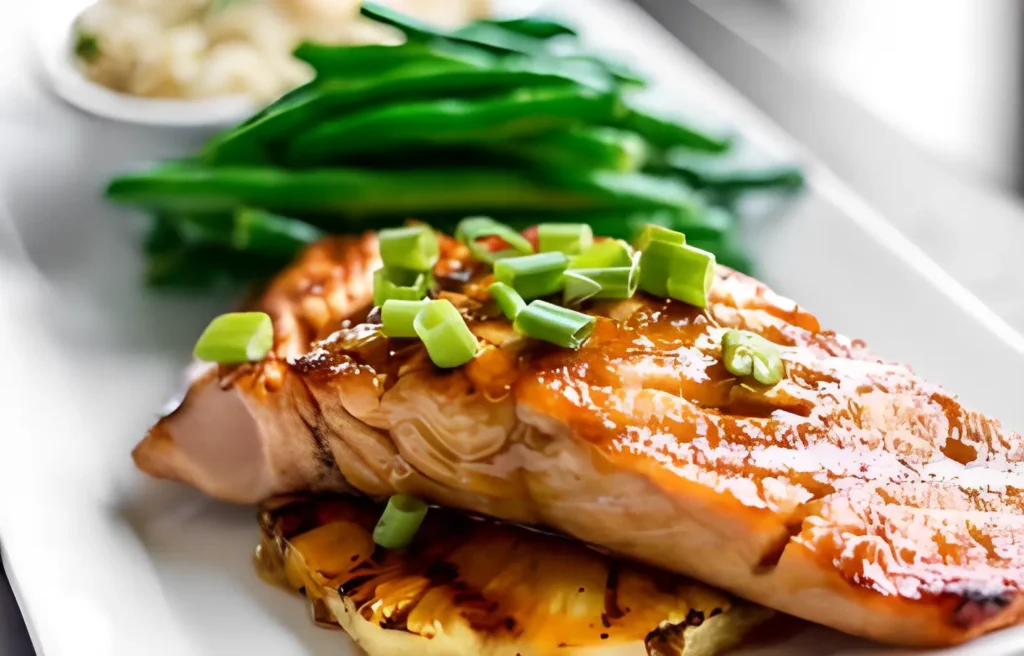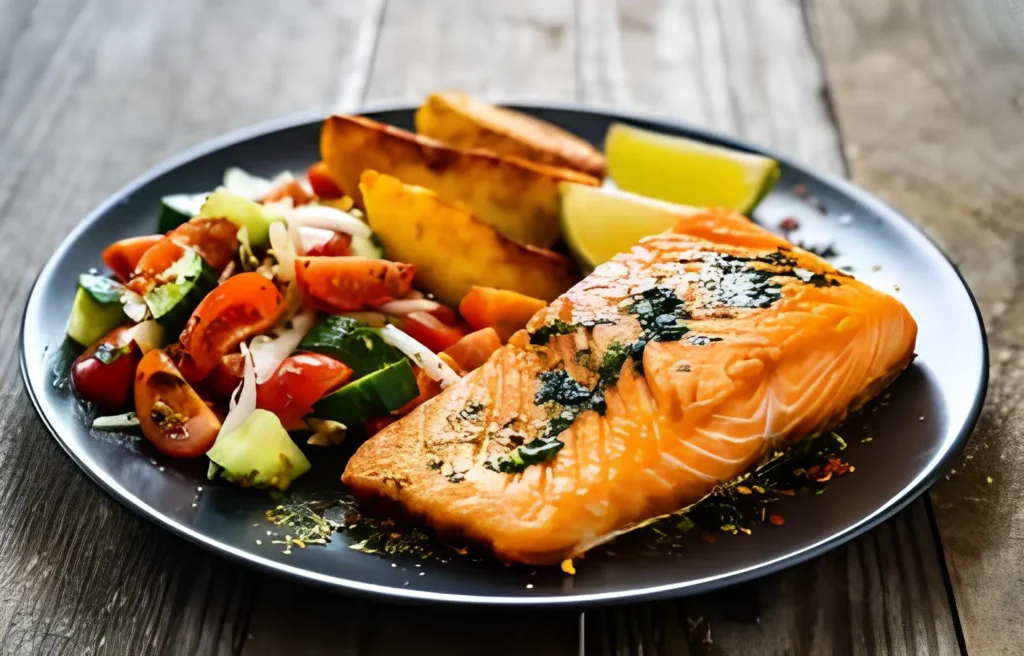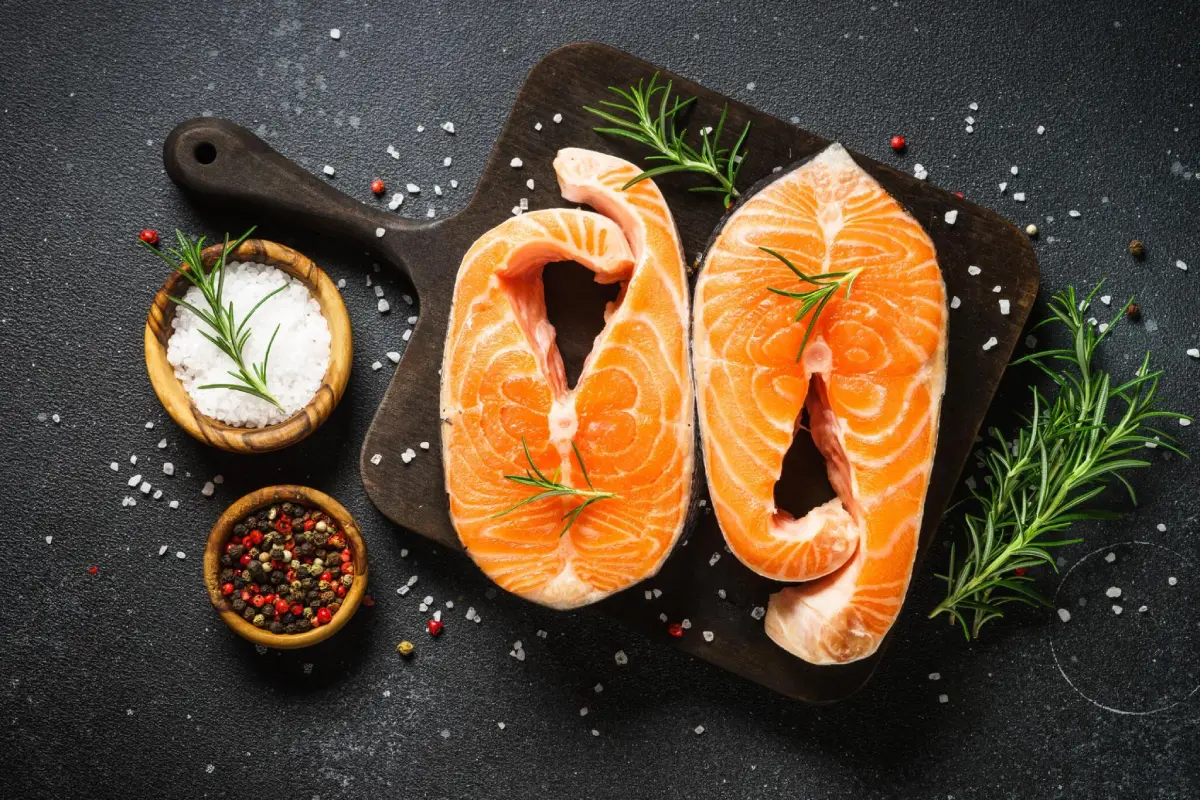In the culinary world, few dishes blend simplicity with sophistication quite like salmon bites. This article dives into the heart of creating these delightful morsels, exploring not just the recipe but the myriad benefits and variations that make them a must-try. From the nutritional powerhouse that is salmon to the art of perfecting the pan-sear, we’ve got you covered. So, whether you’re a seasoned chef or a curiousomega-3 fatty acids foodie, prepare to embark on a flavorful journey that promises to elevate your cooking game.
Introduction to Salmon Bites
Ah, salmon bites—the mere mention conjures images of succulent, flavorful morsels that promise a culinary delight. But what exactly makes these bite-sized wonders stand out in the vast sea of appetizers and entrées? Well, for starters, their versatility is unmatched. Whether you’re looking for a quick snack, a hearty addition to your meal, or a fancy appetizer to impress your guests, salmon bites are up to the task.
At their core, salmon bites are cubed pieces of salmon, marinated and cooked to perfection. The beauty of this dish lies in its simplicity and the depth of flavor achieved with just a few ingredients. Imagine the rich, oily goodness of salmon, enhanced with a glaze that’s sweet, savory, and just a tad spicy—mouthwatering, isn’t it?
But it’s not just about taste. These little nuggets are nutritional goldmines. Packed with omega-3 fatty acids and vitamin D, they’re a healthful choice that doesn’t skimp on flavor. And let’s not forget the appeal of making a gourmet-style dish that’s surprisingly easy and quick to whip up. Whether you opt for wild, farmed, or sockeye, you’re in for a treat.
Moreover, the adaptability of salmon bites is a testament to their popularity. They can seamlessly transition from a casual weeknight dinner to the star of the show at social gatherings. And with the option to pan-sear, bake, or even air-fry, you can tailor them to your dietary preferences and taste.
In the following sections, we’ll delve into the nutritional benefits of salmon, offer a step-by-step guide to preparing irresistible salmon bites, and share serving suggestions that complement their flavors. So, buckle up and get ready to explore the delightful world of salmon bites, where taste meets nutrition in every bite.
Nutritional Benefits of Salmon

Diving into the heart of why salmon bites are not just delicious but also incredibly beneficial for your health, we uncover a treasure trove of nutrients. Salmon, the star ingredient, is renowned for its high content of omega-3 fatty acids, a crucial element that supports heart health, brain function, and overall well-being. But that’s just the tip of the iceberg.
Omega-3 Fatty Acids
Omega-3s are the superheroes of the fatty acid world. Found abundantly in salmon, they play a vital role in reducing inflammation throughout the body, lowering the risk of heart disease, and supporting brain health. Incorporating salmon bites into your diet means you’re not just treating your taste buds but also doing a world of good for your body.
For a deeper understanding of the benefits of omega-3s, consider reading the American Heart Association’s insights on “The Importance of Omega-3 Fatty Acids.”
Vitamin D Content
Next up, let’s talk about vitamin D—the sunshine vitamin. Salmon is one of the few natural food sources rich in vitamin D, essential for bone health, immune function, and mood regulation. Especially for those who don’t get enough sunlight or struggle to maintain adequate vitamin D levels, salmon bites can be a delicious solution.
Protein Source
Salmon is also an excellent source of high-quality protein, essential for building and repairing tissues, protecting bone health, and maintaining muscle mass. It’s a lean protein source that fills you up without the added calories, making salmon bites an ideal choice for those looking to maintain or lose weight.
Environmental and Economic Considerations
When it comes to choosing the type of salmon for your bites, the debate between wild and farmed salmon comes into play. Wild salmon is often praised for its leaner composition and higher concentration of minerals. However, farmed salmon provides a more accessible and cost-effective option without significantly compromising on the nutritional benefits. The key is to find a balance that suits your budget and dietary preferences.
Moreover, turning salmon into bite-sized pieces is not just a culinary trick but also a smart way to make the fish go further, stretching your dollar while still enjoying the rich flavors and health benefits. Whether you’re opting for the luxurious wild-caught or the more budget-friendly farmed variety, salmon bites offer a versatile and nutritious addition to any meal.
In the next section, we’ll guide you through preparing these nutritious salmon bites, ensuring you can enjoy all the health benefits wrapped up in a tasty, easy-to-make package. Stay tuned for a step-by-step cooking guide that will elevate your culinary skills and impress your palate.
Preparing Salmon Bites

Embarking on the culinary adventure of making salmon bites, you’ll find the process surprisingly straightforward, yet the results are nothing short of spectacular. Let’s dive into the ingredients you’ll need, followed by a step-by-step guide to bringing this dish to life.
Ingredients and Substitutions
The beauty of salmon bites lies in their simplicity. Here’s what you’ll need:
- Salmon – Choose any type you prefer: wild, farmed, or sockeye. Each brings its unique flavor and texture.
- Soy Sauce – For that umami kick. Gluten-free tamari or coconut aminos are great alternatives.
- Toasted Sesame Oil – Adds a nutty, rich flavor. Find it in the Asian section of your grocery store.
- Honey – For a touch of sweetness. Maple syrup or brown sugar can substitute.
- Canola Oil – Or any other neutral-tasting oil for searing.
- Optional Ingredients – Sriracha or chili garlic sauce for heat, green onions, and sesame seeds for garnish.
Feel free to tweak the ingredients based on dietary needs or what you have on hand. The goal is to create a dish that’s both delicious and tailored to your taste.
Step-by-Step Cooking Guide
- Cube the Salmon: Start by cutting the salmon into 1-inch cubes. This size ensures quick cooking and a delightful bite.
- Mix the Marinade: Combine soy sauce, toasted sesame oil, and honey in a bowl. Add sriracha if you like it spicy.
- Marinate (Optional): Toss the salmon cubes in the marinade. Let them sit for 30 minutes to 6 hours in the fridge. If you’re short on time, you can skip this step without sacrificing too much flavor.
- Sear the Salmon: Heat a large skillet over medium-high heat and add canola oil. Sear the salmon cubes for 2-3 minutes on each side until nicely browned and cooked through.
- Garnish and Serve: Finish by tossing the cooked salmon bites in the remaining marinade for extra flavor. Garnish with sliced green onions and sesame seeds if desired.
If you’re curious about the environmental impacts of your seafood choices, including salmon, and how to select the best option for your health and the planet, refer to the Environmental Working Group’s Seafood Selector.
Tips for Perfect Salmon Bites
- Achieving the Perfect Sear: Make sure your skillet is hot enough before adding the salmon. A good sear not only adds flavor but also helps the salmon retain its shape.
- Avoid Overcrowding: Cook the salmon in batches if necessary. Overcrowding the pan can steam the fish instead of searing it.
- Utilize the Same Skillet: After removing the salmon, throw in some veggies to cook in the remaining sauce and oil. It’s a great way to build flavor and make a complete meal.
By following these steps, you’ll create salmon bites that are crispy on the outside, tender on the inside, and bursting with flavor. In the next section, we’ll explore creative ways to serve these delightful morsels, ensuring your salmon bites are the highlight of any dining experience.
Serving Suggestions
Once you’ve mastered the art of making salmon bites, the next step is to present them in a way that complements their rich flavor and nutritional value. Here are some creative serving ideas and pairing suggestions to elevate your salmon bites from a simple dish to a memorable meal.
Creative Serving Ideas
- Salmon Bite Bowls: Layer cooked rice or your favorite grain in a bowl, add a generous helping of salmon bites, and top with sautéed vegetables. Drizzle with a bit of the marinade or a sauce of your choice for an extra flavor boost.
- Salmon Bite Appetizers: Skewer salmon bites with small pieces of vegetables like bell pepper, onion, or cherry tomatoes. Serve with a dipping sauce on the side for a fun and elegant appetizer.
- Salmon Bite Salads: Toss your salmon bites onto a bed of mixed greens, arugula, or spinach. Add avocado slices, cherry tomatoes, and a light vinaigrette for a healthy and satisfying salad.
Sides To Pair With Salmon Bites
The versatility of salmon bites means they pair wonderfully with a wide range of sides. Here are a few suggestions:
- Vegetables: Sautéed greens, roasted Brussels sprouts, or a colorful stir-fry can complement the flavors of the salmon bites while adding a variety of textures and nutrients to your plate.
- Grains: Quinoa, basmati rice, or couscous are excellent choices that not only soak up the marinade but also provide a satisfying base for the salmon bites.
- Sauces: A drizzle of soy sauce, a spoonful of sriracha mayo, or a homemade teriyaki sauce can add an extra dimension of flavor to your dish.
When serving salmon bites, the key is to balance the flavors and textures. The rich, umami taste of the salmon pairs well with both light and hearty sides, making it easy to create a meal that satisfies all your cravings.
In the next section, we’ll tackle some frequently asked questions about salmon bites, providing you with all the information you need to enjoy this delicious dish to its fullest. Whether you’re curious about the best type of salmon to use or how to defrost frozen salmon properly, we’ve got you covered.
For creative and healthy ways to serve your salmon bites, including pairing them with various sides and sauces, check out the Environmental Working Group’s recommendations on incorporating sustainable seafood into your diet for a balanced and environmentally conscious meal plan.
Frequently Asked Questions
When it comes to salmon bites, a few questions seem to pop up regularly. Let’s dive into some of the most common inquiries and shed some light on these topics, ensuring you’re well-equipped to make the most out of this delightful dish.
Can I eat the salmon skin?
Absolutely! When crisped up during the cooking process, salmon skin is not only safe to eat but also adds a delightful texture and flavor to your dish. It’s packed with nutrients, too. However, whether or not to include the skin is entirely up to personal preference. If you’re not a fan, feel free to remove it before cubing your salmon.
What kind of salmon should I use?
The great thing about salmon bites is their versatility when it comes to the type of salmon you can use. Wild, farm-raised, sockeye, or any other variety works well. Wild salmon tends to have a more robust flavor and firmer texture, while farm-raised salmon is often more fatty and tender. Consider your taste preference and budget when making your choice. Remember, since you’re cutting the salmon into bites, even less expensive cuts can be used to great effect.
How can I defrost frozen salmon?
If your salmon is frozen, it’s important to defrost it properly to ensure even cooking. The best method is to transfer the salmon from the freezer to the refrigerator and let it thaw overnight. If you’re in a hurry, you can place the salmon in its packaging (or a ziplock bag if it’s not already sealed) in a bowl of cold water. Change the water every 30 minutes until the salmon is thawed. Avoid using hot water or microwaving to defrost, as these methods can partially cook the fish and affect its texture.
By addressing these FAQs, we hope to have cleared up any uncertainties you might have had about preparing and enjoying salmon bites. With these tips and tricks under your belt, you’re all set to impress with your culinary skills.
Stay tuned for the next section, where we’ll explore additional salmon recipes to inspire your next kitchen adventure. Whether you’re looking for something quick and easy or a dish to dazzle dinner guests, we’ve got plenty of ideas to keep your meals exciting and delicious.
Conclusion
As we reach the end of our culinary journey through the world of salmon bites and beyond, it’s clear that salmon is not just a fish; it’s a versatile ingredient that can transform any meal into a nutritious, flavorful feast. From the simplicity of pan-seared bites to the creativity of tacos and frittatas, salmon offers a wealth of possibilities for any cook, regardless of skill level.
We’ve explored the nutritional benefits of salmon, including its rich content of omega-3 fatty acids, vitamin D, and high-quality protein, which contribute to its status as a powerhouse of health. We’ve also delved into the practical aspects of preparing salmon, offering tips and tricks to ensure perfect results every time. And through a variety of serving suggestions and additional recipes, we’ve seen how salmon can be the star of the show in a myriad of dishes, each with its unique flavor profile and appeal.
Cooking with salmon, particularly in the form of salmon bites, is an invitation to experiment with flavors, textures, and cooking techniques. It encourages us to think creatively about our meals, pushing us to explore new culinary horizons while keeping health and nutrition in mind. Whether you’re cooking for one, preparing a family dinner, or entertaining guests, salmon bites and the many other salmon dishes we’ve discussed can adapt to any occasion.
Thank you for joining us on this flavorful journey. May your kitchen be filled with the delightful aromas of cooking salmon, and may each bite bring you joy and satisfaction. Here’s to many more culinary adventures ahead!

